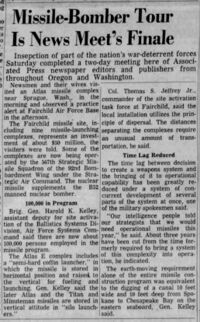1961-10-01-sr-p21-newsman-tour-atlas-missile-site
October 01, 1961 Spokesman-Review Page 21:
Missile-Bomber Tour Is News Meet’s Finale
Inspection of part of the nation’s war-deterrent forces Saturday completed a two-day meeting here of Associated Press newspaper editors and publishers from throughout Oregon and Washington.
Newsmen and their wives visited an Atlas missile complex near Sprague, Wash., in the morning and observed a practice alert at Fairchild Air Force Base in the afternoon.
The Fairchild missile site, including nine missile-launching complexes, represents an investment of about $50 million, the visitors were told, Some of the complexes are now being operated by the 567th Strategic Missile Squadron of the 92nd Bombardment Wing under the Strategic Air Command. The nuclear missile supplements the B52 manned nuclear bomber.
100,000 in Program
Brig. Gen. Harold K. Kelley, assistant deputy for site activation of the Ballistics Systems Division, Air Force Systems Command said there are now about 100,000 persons employed in the missile program.
The Atlas E complex includes “semi-hard coffin launcher,” in which the missile is stored in horizontal position and raised to the vertical for fueling and launching, Gen. Kelley said the later Atlas and the Titan and Minuteman missiles are stored in vertical attitude in “silo launchers.”
Col. Thomas S. Jeffrey Jr., commander of the site activation task force at Fairchild, said the local installation utilizes the principle of dispersal. The distances separating the complexes require an unusual amount of transportation, he said.
Time Lag Reduced
The time lag between decision to create a weapons system and the bringing of it to operational capability has been greatly reduced under a system of concurrent development of several parts of the system at once, one of the military spokesmen said.
“Our intelligence people told our strategists that we would need operational missiles this year,” he said. About three years have been cut from the time formerly required to bring a system of this complexity into operation, he indicated.
The earth-moving requirement alone of the entire missile construction program was equivalent to the digging of a canal 10 feet wide and 10 feet deep from Spokane to Chesapeake Bay on the eastern seaboard, Gen. Kelley said.
